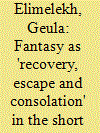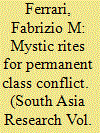|
|
|
Sort Order |
|
|
|
Items / Page
|
|
|
|
|
|
|
| Srl | Item |
| 1 |
ID:
130741


|
|
|
|
|
| Publication |
2014.
|
| Summary/Abstract |
Isaac Bar Moshe (1927-2004) was born in Baghdad and immigrated to Israel in 1950. This article deals with his literary world, which is split between realism on the one hand and fantasy, mysticism and dreams on the other, with both these planes reflecting his perspective on various existential questions. The article focuses on the short stories in his book Behind the Wall (1973), which, like many of his other works, are largely anchored in his private life and depict a bleak reality, with dreams and fantasy offering the only hope of escape into a better, more spiritual world. The article concludes with an analysis of Bar Moshe's stories in terms of the three functions of fantasy - 'recovery, escape and consolation' - as formulated by writer and philologist J.R.R. Tolkien in his book Tree and Leaf.
|
|
|
|
|
|
|
|
|
|
|
|
|
|
|
|
| 2 |
ID:
190222


|
|
|
|
|
| Summary/Abstract |
This paper explores the concepts and norms of gender and sexuality in Ehmedê Xanî's 17th-century mathnawi poem Mem û Zîn, nowadays regarded as the Kurdish national epic. A reading of this poem with the aid of the conceptual tools of gender studies and the history of sexuality reveals how different its norms and concepts are not only from modern Kurdish ones, but also from those of classical Persian literature. Although the poem does not hint at any taboo concerning male love for beardless boys, it does display a remarkable asymmetry between male and female same-sex desire; it also displays distinct views of legitimate and transgressive sexuality. Thus, this poem encourages a more historicizing view of the gendered and sexual dimensions of modern (Kurdish and other) nationalism, and a greater attention for the distinct characteristics of vernacular literatures within the premodern ‘Persianate cosmopolitan.’
|
|
|
|
|
|
|
|
|
|
|
|
|
|
|
|
| 3 |
ID:
112741


|
|
|
|
|
| Publication |
2012.
|
| Summary/Abstract |
Locating itself amidst current debates on post-modern analyses of mysticism, particularly academic debates on the Bauls of Bengal, this article discusses issues of cultural transformation as a result of gentrification and globalisation. It combines the author's ethnographic research and a methodology mainly derived from Italian Marxist critique (Antonio Gramsci, Ernesto de Martino, Antonio Negri and Paolo Virno). The article examines the reification of mysticism and the process of 'rehab', as imposed by Bengali bourgeoisie via the Tagorian archetype and the Western show business on the Bauls, to cleanse their image from inconvenient traits. Suggesting an interpretation of radical materialist mystics as 'multitude' and viewing professional Bauls as 'people', this research explores how the construction of a myth has ultimately penetrated contemporary society at all levels, including academic circles.
|
|
|
|
|
|
|
|
|
|
|
|
|
|
|
|
| 4 |
ID:
125038


|
|
|
|
|
| Publication |
2013.
|
| Summary/Abstract |
WHEN IN ANCIENT TIMES people faced the question of how to ease pain in the human body, two approaches emerged. One of them was to study the system of the human body with examples of both dead and living people. In the 11th century BC, the first anatomical atlas of a healthy man appeared, and in the 19th century AD, it was complemented by indicators of normal physiology to take account of the process of disease. Ancient doctors realized that only with reliable information about human body maladies can their diagnosis be made with certainty and cures found.
|
|
|
|
|
|
|
|
|
|
|
|
|
|
|
|
|
|
|
|
|